Editor's note: This story is based on Initial analysis Federal News Network's April 2024 Federal Employee Return to Work Survey Results. This article contains results for some, but not all, of the survey questions.
As government agencies bring employees back to the office on a more regular basis, some federal employees have reported to work only to find nearly empty cubicles waiting for them.
in spite of, administrative push To encourage more collaboration and “meaningful” work within the office, many federal agencies have limited or no physical space to effectively host team meetings and events. Employees said this is the reality.
“This is a cubicle city,” wrote one Federal News Network respondent. recent research More than 6,300 current federal employees.
When it comes to physical office space, the results of the return-to-office survey were almost evenly divided. Employee responses showed a roughly even number of employees who believed their office space was sufficient, insufficient, or somewhere in between.
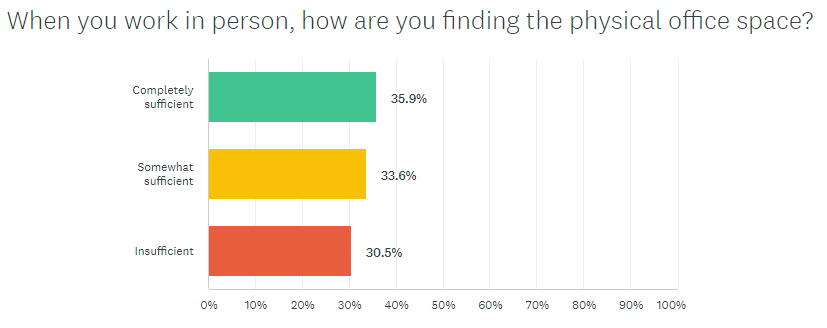
As more employees commute into offices more frequently, some survey respondents say they're having trouble finding the right type of space to work in, or having enough space in the first place. He says that it is becoming difficult. Others said office layouts have not adapted or reflected the changing needs of in-person work.
“We don't have great meeting space,” one survey respondent wrote. “Last week, I tried to meet a colleague on the same floor, but we couldn't connect because we didn't have a big screen. We had to work side by side on our laptops.”
People working cubicle-style work arrangements in old federal buildings said the arrangement was distracting, especially for those who had spent years getting accustomed to working from home arrangements. Employees said they can often hear other people's conversations and phone calls when working in cubicles. decreased productivity.
“Having to listen to all the program meetings is very distracting. Not to mention, it's nerve-wracking when someone comes to work sick,” one respondent wrote.
Another survey respondent said, “My new desk arrangement is uncomfortable and doesn't help me relax and concentrate while working. [There are] smaller cubicle [and] Half of it is a wall, positioned so that we have our backs to everyone else. ”
Some respondents expressed a desire for their agency office space configuration to be more aligned with management goals of in-person work. They said agencies should place more emphasis on collaborative co-working spaces, rather than isolating employees to complete individual tasks.
“I wish our office had more team and meeting space.” [and] workshop space. That’s what we need,” one respondent wrote. “We don't need butts in seats. We need space to sit. That's the only beneficial aspect of our office.”
Balancing space and design after returning to the office
The return-to-office findings contrast with efforts by agencies to arrange “core collaboration days” where employees adjust their in-office schedules to work in-person on the same day of the week. In the survey, The results were relatively neutral About the impact of those collaborations.
At the same time that agencies are struggling to reduce their physical footprint, employees are also concerned about the functionality of their office space.a recent reports A study by the Public Building Reform Commission found that government agencies have more office space than federal employees need, and the cost of maintaining that space continues to rise.
But at the same time, the board said that when selling or disposing of unwanted real estate, agents have the following criteria: unique opportunity You can reinvest your budget into office space with state-of-the-art equipment and improve staff morale.
General Services Administration guiding principles When it comes to federal office space, we recognize that while the need for office space remains, its purpose is changing. The focus now is on creating space for collaboration and connection within a large-scale environment. hybrid federal employee.
GSA has worked to improve the functionality of office spaces through the creation of the Workplace Innovation Lab (WIL). Federal employees and teams can reserve space in our D.C.-area coworking spaces with comfortable furniture, innovative meeting layouts, and technology for employee collaboration.
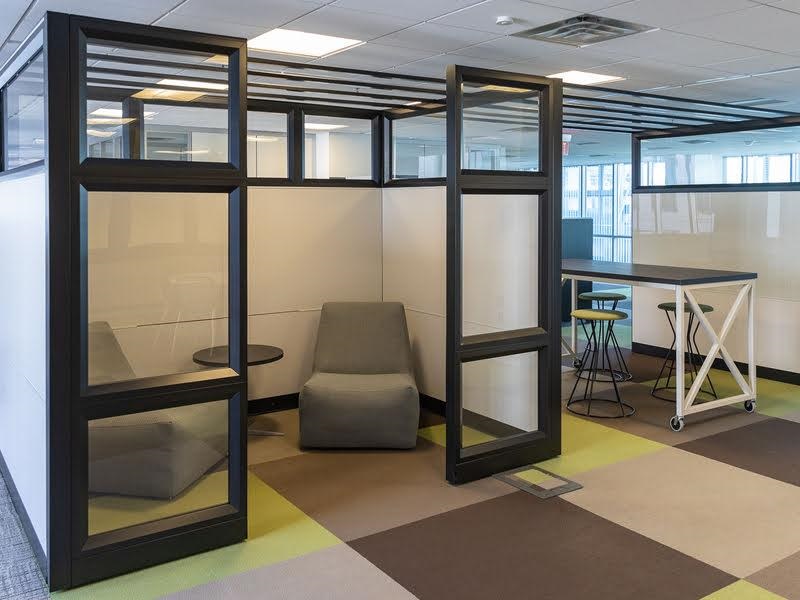

For example, some WIL workspaces include cubicles that have been reconfigured for small team meetings rather than individual work.
Chuck Hardy, GSA Chief Architect, told Federal News Network In February, we said that agencies as a whole should ensure that workspaces are agile and flexible enough to accommodate the current working environment, while also preparing for potential changes in the future.
Resources in and around the office, grocery options
Employees said some resources are limited, both in and around the office, as well as office space. For example, the federal government said in a return-to-office study that there aren't enough affordable, healthy lunch options near some federal buildings. For some, federal government cafeterias and vending machines leave much to be desired.
Since returning to the office more frequently, more than half of survey respondents said their food options were “inadequate.”
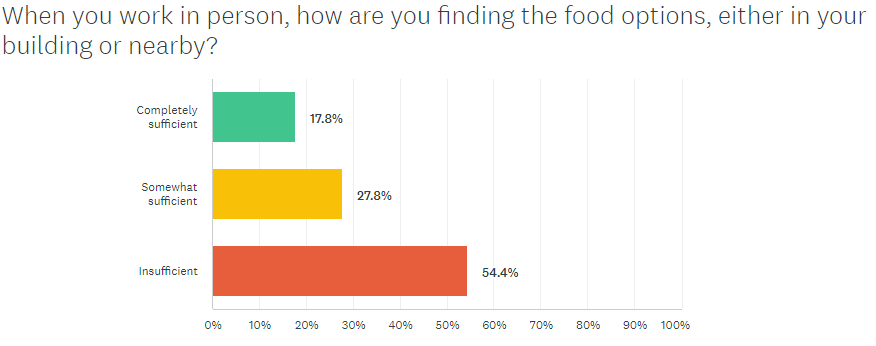

“Cafeterias are too expensive and the food isn't good enough,” one survey respondent wrote. “The distance to go to get food takes up most of my lunch time. I can't drive anywhere because I don't have time. It's the distance to walk to my car and drive back.”
Other survey respondents said there were no food options nearby.
“Our office cafeteria has been closed,” one respondent wrote. “To eat lunch, you have to bring it from home or walk more than a mile each way.”
Another respondent said, “Food options do not exist in the building. The large modern cafeteria has been closed for four years.”
By comparison, nearly 80% of survey respondents felt that office equipment such as chairs and desks, as well as computers and other in-office technology, were somewhat or completely available.
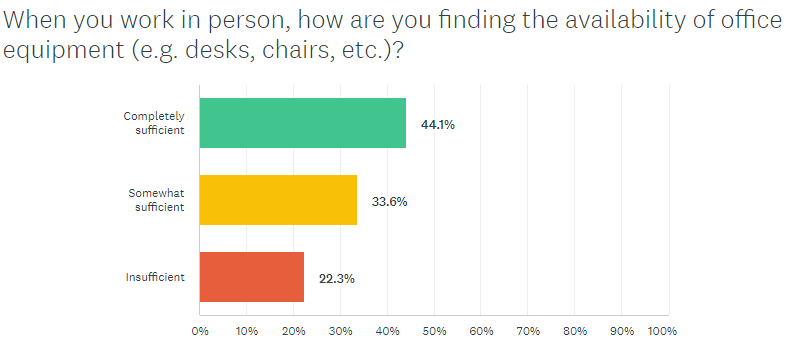

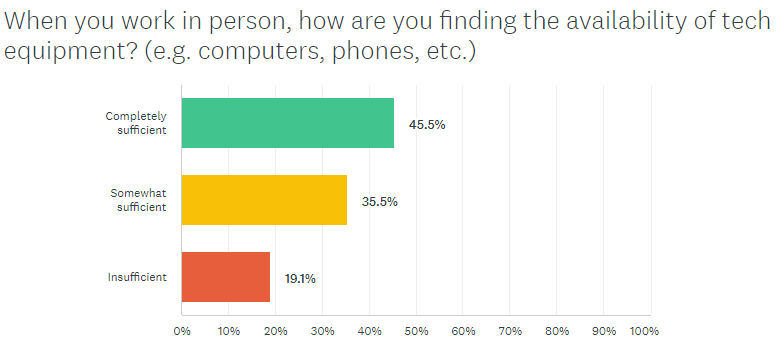

However, some survey respondents still expressed concerns about shared spaces, as well as the use of shared hotels and desks. Several respondents pointed out that if there are too many employees present on a particular day, not everyone will be able to get their own desk.
Space availability varies primarily by agency and specific office building.
For example, one survey respondent wrote, “Hotel space is adequate, but remote meetings are problematic, and conference rooms are not the space needed for successful hybrid meetings.”
However, another respondent said, “Hotel space is very limited. The facilities in hotel space are hit or miss. Some are quite old.”
Still, some employees said they don't feel the desire or need to come to work in person, regardless of the availability of resources or collaboration space within the office. As with many back-to-office surveys, the majority of respondents said they were more productive while working remotely.
One respondent wrote, “When compared to the comforts offered at home, the office offers no facilities or amenities that are attractive enough to justify the commuting and commuting costs.'' ing.
Copyright © 2024 Federal News Network. All rights reserved. This website is not directed to users within the European Economic Area.
Summarize this content to 100 words
Editor's note: This story is based on Initial analysis Federal News Network's April 2024 Federal Employee Return to Work Survey Results. This article contains results for some, but not all, of the survey questions.
As government agencies bring employees back to the office on a more regular basis, some federal employees have reported to work only to find nearly empty cubicles waiting for them.
in spite of, administrative push To encourage more collaboration and “meaningful” work within the office, many federal agencies have limited or no physical space to effectively host team meetings and events. Employees said this is the reality.
“This is a cubicle city,” wrote one Federal News Network respondent. recent research More than 6,300 current federal employees.
When it comes to physical office space, the results of the return-to-office survey were almost evenly divided. Employee responses showed a roughly even number of employees who believed their office space was sufficient, insufficient, or somewhere in between.
Source: Federal News Network April 2024 Return to Office Survey of 6,300 Federal Employees.
As more employees commute into offices more frequently, some survey respondents say they're having trouble finding the right type of space to work in, or having enough space in the first place. He says that it is becoming difficult. Others said office layouts have not adapted or reflected the changing needs of in-person work.
“We don't have great meeting space,” one survey respondent wrote. “Last week, I tried to meet a colleague on the same floor, but we couldn't connect because we didn't have a big screen. We had to work side by side on our laptops.”
People working cubicle-style work arrangements in old federal buildings said the arrangement was distracting, especially for those who had spent years getting accustomed to working from home arrangements. Employees said they can often hear other people's conversations and phone calls when working in cubicles. decreased productivity.
“Having to listen to all the program meetings is very distracting. Not to mention, it's nerve-wracking when someone comes to work sick,” one respondent wrote.
Another survey respondent said, “My new desk arrangement is uncomfortable and doesn't help me relax and concentrate while working. [There are] smaller cubicle [and] Half of it is a wall, positioned so that we have our backs to everyone else. ”
Some respondents expressed a desire for their agency office space configuration to be more aligned with management goals of in-person work. They said agencies should place more emphasis on collaborative co-working spaces, rather than isolating employees to complete individual tasks.
“I wish our office had more team and meeting space.” [and] workshop space. That’s what we need,” one respondent wrote. “We don't need butts in seats. We need space to sit. That's the only beneficial aspect of our office.”
Balancing space and design after returning to the office
The return-to-office findings contrast with efforts by agencies to arrange “core collaboration days” where employees adjust their in-office schedules to work in-person on the same day of the week. In the survey, The results were relatively neutral About the impact of those collaborations.
At the same time that agencies are struggling to reduce their physical footprint, employees are also concerned about the functionality of their office space.a recent reports A study by the Public Building Reform Commission found that government agencies have more office space than federal employees need, and the cost of maintaining that space continues to rise.
But at the same time, the board said that when selling or disposing of unwanted real estate, agents have the following criteria: unique opportunity You can reinvest your budget into office space with state-of-the-art equipment and improve staff morale.
General Services Administration guiding principles When it comes to federal office space, we recognize that while the need for office space remains, its purpose is changing. The focus now is on creating space for collaboration and connection within a large-scale environment. hybrid federal employee.
GSA has worked to improve the functionality of office spaces through the creation of the Workplace Innovation Lab (WIL). Federal employees and teams can reserve space in our D.C.-area coworking spaces with comfortable furniture, innovative meeting layouts, and technology for employee collaboration.
Image of GSA Workplace Innovation Lab collaborative office space (Source: General Services Administration)
For example, some WIL workspaces include cubicles that have been reconfigured for small team meetings rather than individual work.
Chuck Hardy, GSA Chief Architect, told Federal News Network In February, we said that agencies as a whole should ensure that workspaces are agile and flexible enough to accommodate the current working environment, while also preparing for potential changes in the future.
Resources in and around the office, grocery options
Employees said some resources are limited, both in and around the office, as well as office space. For example, the federal government said in a return-to-office study that there aren't enough affordable, healthy lunch options near some federal buildings. For some, federal government cafeterias and vending machines leave much to be desired.
Since returning to the office more frequently, more than half of survey respondents said their food options were “inadequate.”
Source: Federal News Network April 2024 Return to Office Survey of 6,300 Federal Employees.
“Cafeterias are too expensive and the food isn't good enough,” one survey respondent wrote. “The distance to go to get food takes up most of my lunch time. I can't drive anywhere because I don't have time. It's the distance to walk to my car and drive back.”
Other survey respondents said there were no food options nearby.
“Our office cafeteria has been closed,” one respondent wrote. “To eat lunch, you have to bring it from home or walk more than a mile each way.”
Another respondent said, “Food options do not exist in the building. The large modern cafeteria has been closed for four years.”
By comparison, nearly 80% of survey respondents felt that office equipment such as chairs and desks, as well as computers and other in-office technology, were somewhat or completely available.
Source: Federal News Network April 2024 Return to Office Survey of 6,300 Federal Employees.
Source: Federal News Network April 2024 Return to Office Survey of 6,300 Federal Employees.
However, some survey respondents still expressed concerns about shared spaces, as well as the use of shared hotels and desks. Several respondents pointed out that if there are too many employees present on a particular day, not everyone will be able to get their own desk.
Space availability varies primarily by agency and specific office building.
For example, one survey respondent wrote, “Hotel space is adequate, but remote meetings are problematic, and conference rooms are not the space needed for successful hybrid meetings.”
However, another respondent said, “Hotel space is very limited. The facilities in hotel space are hit or miss. Some are quite old.”
Still, some employees said they don't feel the desire or need to come to work in person, regardless of the availability of resources or collaboration space within the office. As with many back-to-office surveys, the majority of respondents said they were more productive while working remotely.
One respondent wrote, “When compared to the comforts offered at home, the office offers no facilities or amenities that are attractive enough to justify the commuting and commuting costs.'' ing.
Copyright © 2024 Federal News Network. All rights reserved. This website is not directed to users within the European Economic Area.
https://federalnewsnetwork.com/workforce/2024/04/survey-back-in-the-office-feds-feel-mixed-on-office-space-functionality/ Back at the office, administrators have mixed feelings about how their office spaces will function.